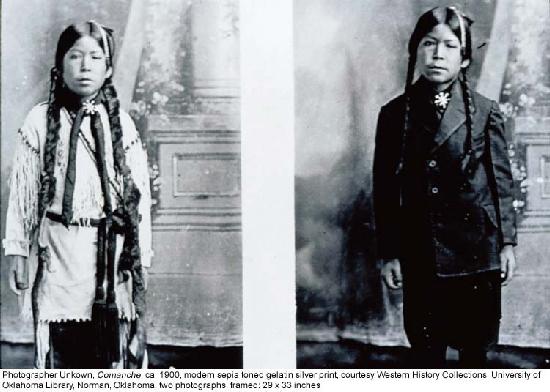|
|
Canku Ota |
|
|
(Many Paths) |
||
|
An Online Newsletter Celebrating Native America |
||
|
April 6, 2002 - Issue 58 |
||
|
|
||
|
Palm Beach Schools Exhibit Chronicles 'Trail of Tears' |
||
|
by Kellie Patrick Education
Writer Sun-Sentinel
|
||
|
But the struggles of the many Native American tribes didn't end with what the Cherokee call the Trail of Tears, a forced migration carried out with a 116-day march in the late 1830s. Their fight to survive with their cultures intact was captured with a technology still relatively new at the time -- the camera. Next month, 37 images focusing on the aftermath of that cross-country march will fill the lobby of the Palm Beach County School District's headquarters in an exhibit called "Moving the Fire." Open to all, it will be used by teachers to help students understand the history of Native Americans and the actions against them by the US and European colonial governments. Students will also learn how modern Native American culture was shaped by those events and how Native Americans have contributed to modern US culture, said multicultural department planner Steve Byrne. The Indian Removal Act signed by President Andrew Johnson allowed eastern Indian tribes to be moved west of the Mississippi and prompted the Trail of Tears. Rounded up beginning in May 1838, the tribes traveled mostly on foot to Oklahoma. An estimated 4,000 Cherokees died from starvation, cold weather and disease. Teachers will take special note of the Seminole tribe. One photograph in the exhibit captures part of the history of the Seminoles who were forced to move to Oklahoma. But, Byrne said, students will also learn about those who resisted, fighting back and moving deeper into the Florida swamps. Patricia R. Wickman, the Seminole Nation of Florida's historic preservation officer, and Lewis Johnson, a citizen of the Seminole Nation of Oklahoma and the assistant curator of the tribe's museum, both hope those who see "Moving the Fire" will learn Native Americans' suffering only helped to make the Seminoles more resolute. "The people in Florida today are only here because of the passion, the commitment, the very lifeblood of the people who would not move their fires," Wickman said. Johnson thinks the events made the Seminoles more adaptable, with those remaining in Florida adapting to the harsher conditions of the deep swamp and those in Oklahoma learning to live in a different environment. Johnson's museum hosted "Moving the Fire" several years ago. It provides a broad, pictorial overview of many tribes' experiences, he said, but doesn't delve deeply into the politics of the time. He is pleased the school district is developing lessons to give students knowledge beyond what the pictures show. Johnson enjoys talking to young people about the contributions the Seminoles and other Native Americans have made to US culture. Many modern medicines have been derived from plants whose healing properties were discovered and shared by native North or South Americans, he said. Johnson also thinks the Native American love of freedom and willingness to fight for it has been infused into US culture. The US government considers Florida's Seminoles and Oklahoma's Seminoles two different tribes. Members of each tribe recognize their common ancestry, and visitors travel back and forth. Johnson lived for a few years on the Florida reservation. Wickman, who is not a member of the tribe but was invited to be its historian, travels to Oklahoma each year to do genealogical and historical research. One of her main goals is to pinpoint how many Seminoles managed to elude the government to stay in Florida, their "ancestral seat." She doubts it was more than 300. In theory, that should not have been enough to sustain the tribe. They should have died off. But instead, the Seminole Tribe of Florida today has almost 3,000 citizens. She wants students to know that Native Americans came through the forced march and relocation with their cultural identities intact. "They were not destroyed. They were not fragmented. They haven't lost their culture," she said. "They are still here. And that survival is nothing short of miraculous, but it's real." A few years ago, Johnson went to a festival where traditional Seminole dances were performed. He was deeply moved by the words of one of the elders who spoke. "He said, `What you see here today, the dancing and the traditions of our people, continued because someone believed it could continue. People had to lay down their lives. Don't take it for granted.'"
|
|
|
||
|
|
||
| Canku Ota is a free Newsletter celebrating Native America, its traditions and accomplishments . We do not provide subscriber or visitor names to anyone. Some articles presented in Canku Ota may contain copyright material. We have received appropriate permissions for republishing any articles. Material appearing here is distributed without profit or monetary gain to those who have expressed an interest. This is in accordance with Title 17 U.S.C. section 107. | ||
|
Canku Ota is a copyright © 2000, 2001, 2002 of Vicki Lockard and Paul Barry. |
||
|
|
|
|
|
The "Canku Ota - A Newsletter Celebrating Native America" web site and its design is the |
||
|
Copyright © 1999, 2000, 2001, 2002 of Paul C. Barry. |
||
|
All Rights Reserved. |
||

 Dreaming
of a country that spanned a continent, U.S. government officials forced
the people living on land they loved to leave their homes and move westward.
Dreaming
of a country that spanned a continent, U.S. government officials forced
the people living on land they loved to leave their homes and move westward.
